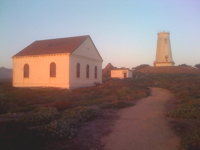![]()
Field Notes 2011 June 1: We finished the season today with our 5th consecutive day of no sightings. Total count for the year is 255 calves, which is a nice positive turn. I haven't done all the math yet but I think that our total estimate of northbound calves will put us around 850 for the season. This is slightly above the average for our 18-year history of counting. The really good news is that next year looks even better. Gray whales are showing up off Barrow, Alaska already, which is really early. May 17: Last week was a good one. Nice weather and a steady stream of cows with calves. We had 63 calves logged during our 5 days of effort (M-F), bringing our annual total to 239. It looks like the parade is really slowing down because on Monday (May 16) we had no calves sighted. We plan to maintain watches for another two weeks at least. May 10: We had 11 calves today (Monday). On Friday when we ended the day we were up to 176 calves, so today it's 187. Looks like a good year, not great, but certainly better than the last four. Looks like we may extend the counts through the first of June if whales keep coming by. April 30: This week was a bit challenging due to high winds along the Central California Coast, but the team counted 71 northbound calves, bringing our total for the season to 118. We are at about the mid-point of the survey and our cumulative count to date already exceeds the total counts for three of the past 4 years. Things are looking good for a strong recruitment class of 2011. April 26: Today was even better than yesterday, with 19 calves passing through. So we are on track for a fair year, which is much better than what we have had.. April 25: We had 17 cow/calf pairs today! This puts our total well into the 60s, which suggests that at least we will beat last year's low total of 71 calves. For the past 3 years our estimates of total calves have been lower than predicted by ice alone, indicating that maybe the impact of ice is getting more significant than it was earlier. If this week continues as it has started, we could have our first year of positive residuals to the model (more calves than predicted). April 24: Although we lost about a day and quarter of effort (16 hrs) to fog this week, the team sighted 31 c/c pairs bringing our season total to 47 northbound calves. Our total at this date puts us on a pace for another year of low calf production, but the counts are still increasing steadily so there is still hope for an upswing this season. The good news for next season is that ice extent in the Bering Sea during March was the second lowest ever recorded and the melt of in April points towards low ice cover in the northern Bering when pregnant female gray whales return to feed. If this pattern continues, next season looks very encouraging for an increase in gray whale calves. April 17: The northbound pulse of gray whale calves is now in full swing as counts jumped from 2 the previous week to 14 this week. The flow of northbound adults and juveniles has decreased to insignificant numbers. Northbound migration of calves is starting a bit late this year with the current total count of 16 calves falling near the lower end of the range of counts by this date over the past 17 seasons of surveys. Next week will go a long way towards telling us whether this season will show a recovery in calf production for this population or, as predicted by the timing of the melt of seasonal ice in the Arctic, present us with another year of low recruitment for eastern gray whales. April 11: We saw 2 calves last week (April 4 and April 8) and the number of adults and juveniles passing offshore dropped from over 200 to about 100. We are in that transition from one phase of the migration to the next. This week we should see more action. Things are starting a little slow, but the timing of the northbound migration varies a fair amount between years. April 2: We finished a very lovely first week of watches with total sightings of 207 adult and juvenile gray whales migrating north, but no calves this week. This is not at all unusual for late March and early April. Expect some action next week. March 29: Good weather and lots of adults and juveniles streaming past. Over 40 animals yesterday (March 28, day 1) and we're seeing about the same today. No cows with calves yet, but we are at the ready. March 16: We will start the survey on March 28 and continue until we run out of whales, usually the last week of May. It looks like a good season from what I hear from folks at the lagoons. In the Arctic, last March was the biggest ice month in decades but ice melted very fast. I would predict a slight up turn in calf production just based on ice, but there are a bunch of girls who haven't had babies in years so there is a reproductive momentum that we have to take into account.
|
|






